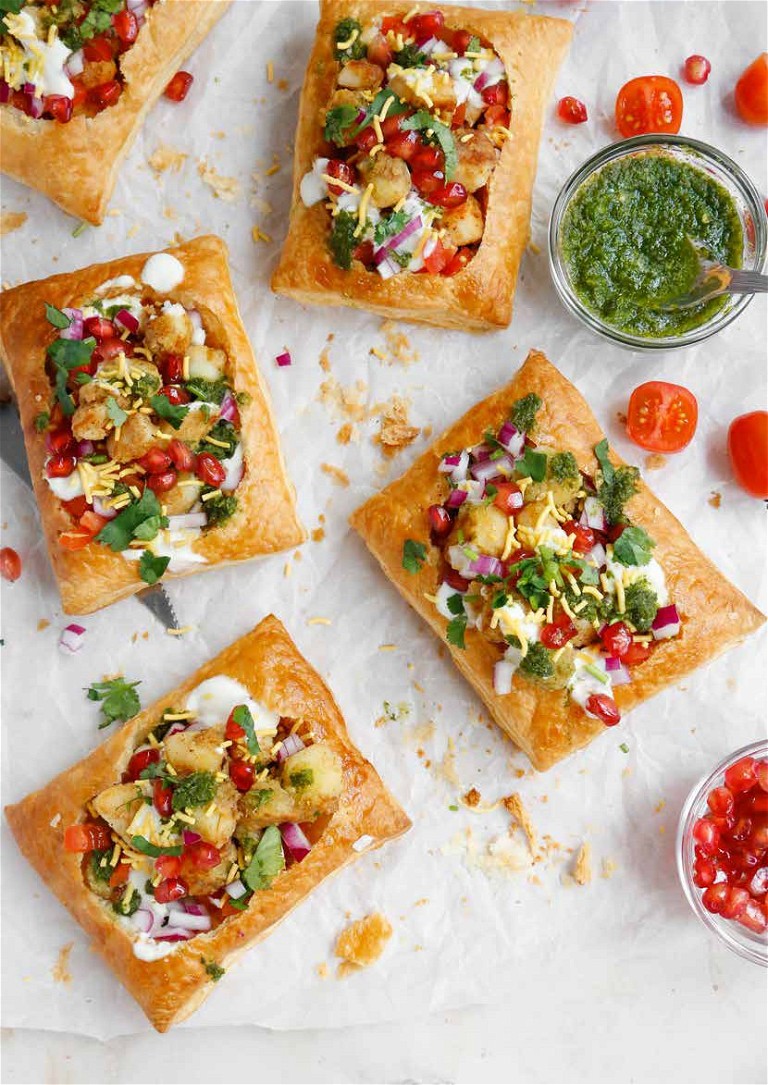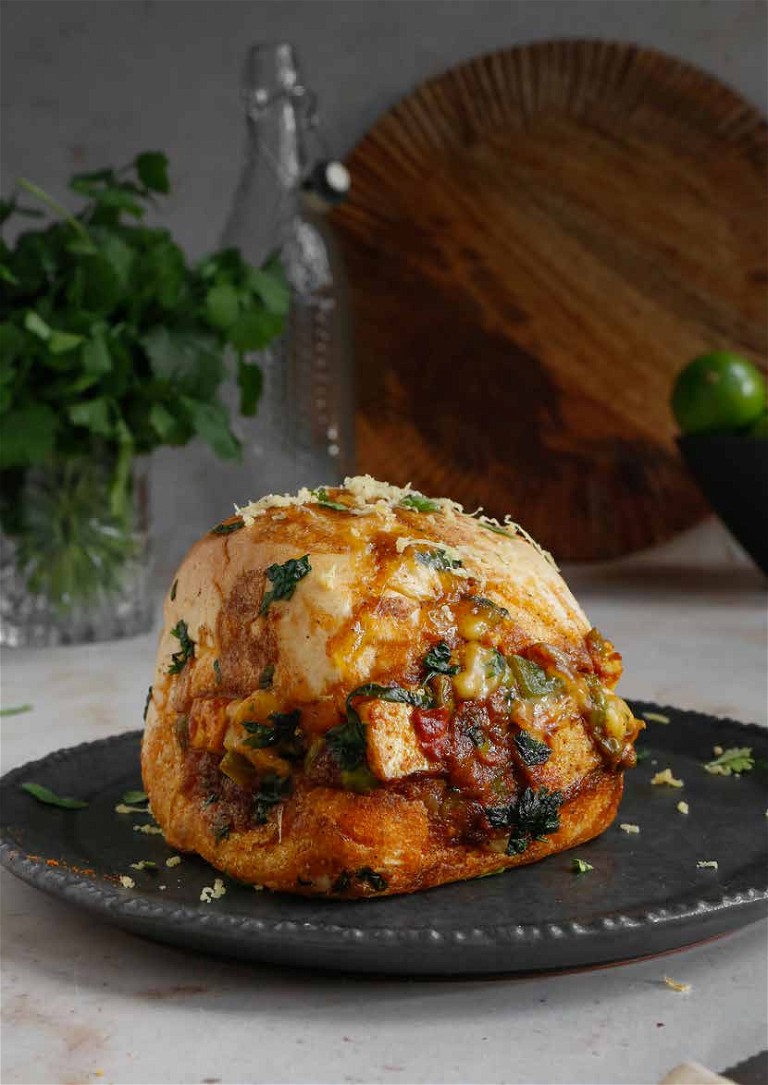COOKING WITH PARITA
Parita Kansagra shares three vegan Indian recipes packed with flavour

"Hi! My name is Parita, and I’m a vegan food blogger and recipe developer. I went vegan for the animals and found showcasing delicious vegan recipes to my friends and family was the most compelling way to introduce my new lifestyle change. Through CookingWithParita I’m able to share my love for Indian cooking, from whole foods to indulgent recipes. You’ll find more of my mouthwatering recipes on my blog: cookingwithparita.com. I’d love to see and repost the recipes you try from this magazine issue, so don’t forget to tag me @ParitaKansagra on Instagram and @CookingWithParita on Tiktok.

PUFF PASTRY ALOO CHAAT
Makes 8
Time needed: 40 minutes
Ingredients
For the green chutney
1 cup packed coriander
1 tsp salt
2 tsp sugar
2 tbsp water
1 tbsp lemon juice
1–3 green chillies
For the puff pastry aloo chaat
4–5 potatoes (800 g) 2 tbsp olive oil Salt and black pepper ½ tsp cumin powder ½ tsp chilli powder ½ tsp chaat masala Puff pastry ready-rolled sheet Oat milk for brushing 1 red onion, diced 8–10 cherry tomatoes, diced 5 tbsp vegan yoghurt ½ cup pomegranate seeds 3–4 tbsp sev 1–2 tbsp fresh coriander
Did you know?
Sev is an Indian snack made with chickpea flour. It adds a wonderful crunch to this puff pastry chaat.
You can find this at your local Indian supermarket or even online.
This Indian street food-inspired dish comes together with store-bought puff pastry, potatoes, spices, vegan yoghurt, pomegranate seeds, sev and a quick green chutney. It’s a super simple recipe that’s perfect for an appetiser, lunch or side dish.
Directions
First make the green chutney by adding the coriander, salt, sugar, water, lemon juice and green chillies into a food processor and blending until the mixture is smooth. Set this aside.
Place the potatoes in a pot filled with cold water and boil until just cooked. Drain and allow the potatoes to cool slightly before peeling the skin off and cutting them into medium-small sized cubes.
Heat the oil in a non-stick pan and add the potatoes to cook for 3 minutes on high or until they start to get a little crispy. Turn the heat down to medium. Add the salt, black pepper and cumin powder and cook for 2–3 minutes. Add the chilli powder and chaat masala. Cook for another 2 minutes and set aside.
Cut the puff pastry sheet into 8 rectangles. Brush with a little oat milk and bake following the packaging instructions.
With a spoon, deflate the middle of each puff pastry, leaving a border. Add the aloo chaat, tomatoes and onions to the centre of each pastry. Drizzle with green chutney and vegan yoghurt. Garnish with pomegranate seeds, sev and fresh coriander.
TAHINI CHOCOL ATE CHIP COOKIES

Makes 22
Ingredients
2 tsp flax meal
4 tsp hot water
113 g vegan salted butter, room temperature
100 g light brown sugar
100 g granulated sugar
100 g tahini
2 tsp vanilla extract
140 g plain flour
1 tsp baking soda
½ tsp salt
250 g vegan dark chocolate chips
Time needed: 3hrs 30 mins
These vegan Tahini Chocolate Chip Cookies make for the most incredible chewy, soft, decadent dessert. These are perfectly salty and sweet, plus they are easy to make and use simple ingredients – what’s not to love?
Directions
Combine the flax meal with the hot water to make a “flax egg” and set aside.
Beat the butter with the light brown sugar and the granulated sugar until the mixture is light and fluffy. Add the well-stirred tahini, vanilla extract, flax egg and mix.
Add the plain flour, baking soda and salt and mix until combined. Fold in the vegan dark chocolate chips. Cover the bowl with a plate and refrigerate overnight (or for at least 3 hours).
Pre-heat the oven to 180 °C and line a baking sheet with parchment paper. Take the cookie dough out of the fridge and allow it to come back to room temperature – this should take around 30 minutes. Use a tablespoon to take two scoops of the cookie dough, and roll this into a ball. Place the cookie balls on the baking sheet, leaving a 2-inch gap between each ball.
Bake the cookies for 13–14 minutes or until the edges start to become golden.
Sprinkle the warm cookies with salt flakes. Allow them to cool for 5 minutes on the baking tray before transferring onto a wire rack to cool for another 5 minutes.
TOFU TAWA BURGERS

Makes 6
Time needed: 40 minutes
Ingredients
2 tbsp sunflower oil
1 onion, diced
½ tsp grated ginger
1 ½ tsp grated garlic
1 bell pepper, diced
½ frozen peas
2–3 tomatoes, diced Salt and black pepper
½ tsp chilli powder
½ tsp ground turmeric
1 tbsp pav bhaji masala
2 tbsp tomato sauce
1 firm tofu block (280 g), cut into small cubes
1 cup vegan cheese, grated
3–4 tbsp chopped coriander
6 medium soft rolls
2–4 tbsp vegan butter
Did you know?
Pav bhaji masala is a blend of spices. You can make your own blend at home, but storebought makes everything easier. You’ll find this in your local Indian supermarket or online.
If you’re in the mood for something packed with flavour, make these Tofu Tawa Burgers! The juicy filling is made with tofu, frozen peas, spices, vegan cheese, tomato sauce and fresh coriander. ‘Tawa’ means ‘pan’, and these pan-fried burgers are made with a little coriander, pav bhaji masala and vegan cheese.
Directions
Heat the oil in a pan over a high heat. Add the onions, ginger and garlic to the pan and cook for 1–2 minutes or until the onions are translucent.
Add the bell pepper, peas and tomatoes to the pan, mixing to combine. Add the salt, black pepper, chilli powder, ground turmeric and pav bhaji masala. Cook for 2–4 minutes.
Mix in the tomato sauce and firm tofu and cook for another 2 minutes. Turn the heat to low, add half of the vegan cheese and continue cooking until it has melted. Sprinkle with 1 tbsp chopped coriander.
Split the burger buns in half lengthways and fill with the tofu filling.
Heat a pan with vegan butter, sprinkle with a little pav bhaji masala, chopped coriander, vegan cheese and mix. Dip each burger into the butter masala to cover entirely. Hold the burger and carefully press and flip until all sides are golden and warm.